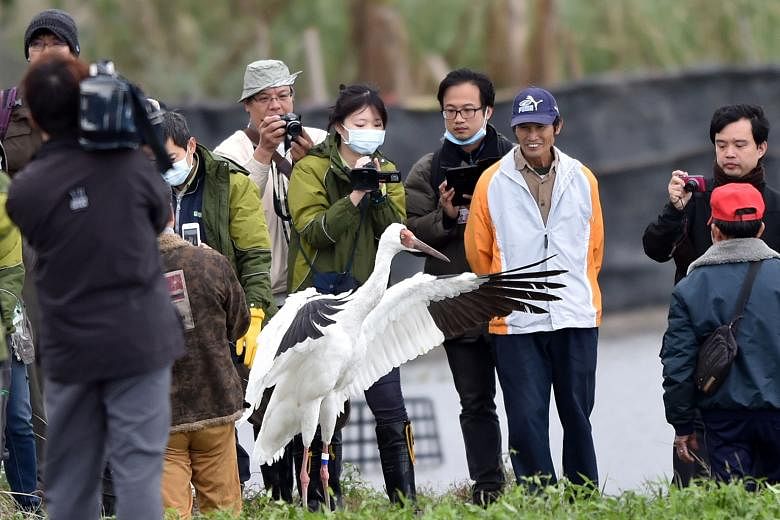TAIPEI • It has a Facebook page, two books and its own brand of rice. A Siberian crane that landed in Taiwan after getting lost during migration over a year ago even made international headlines when it was found outside a train station.
But to conservationists, the crane is more than just a flash-in-the-pan media star. It is a godsend in their push for environmentally friendly farming as the island's birds suffer at the hands of development and pollution.
Taiwan is a mid-point stop on one of the world's eight major migratory routes and a wintering ground for numerous waterbirds from Siberia, China, Japan and the Korean Peninsula on their way further south.
However, in some areas of the island, waterbird numbers are down due to the destruction of habitats.
There had never been any reported sightings of the rare white crane in Taiwan until December 2014, when the crane first made it to the island after taking a wrong turn on its migratory route. It hit the headlines again last winter when it was found wandering around a subway station in Taipei.
The Siberian crane is on the International Union for Conservation of Nature's red list of critically endangered species, with an estimated population of less than 4,000.
"I didn't expect the crane to stay. I thought it would fly away very soon," said farmer Huang Cheng-chun, whose rice and lotus field in Jinshan is nicknamed "little crane base" since the bird took residence there.
"When I work, the crane follows me around. It's like a friend to me. It's been helpful by eating a lot of apple snails (a pest) in the field."
As the crane helped rid farmers of pests, more people in the area agreed to go green to protect the bird's health, a boost for ecologists, who had until then been struggling to persuade them to stop using pesticides, rat poisons and herbicides.
Last year, pre-orders for "Jin Ho rice" - which combines Jinshan and the Chinese word for crane "ho" - were sold out months before the harvest. The eco-friendly farming area in Jinshan has now expanded from 3.5 to 10ha.
"It's inevitable that the bird will leave," said Mr Liao Jen-hui, director of the Taiwan Ecological Engineering Development Foundation. "We hope that by the time it's gone, eco-friendly farming and the Jin Ho rice brand will be well established."
Thanks to safer farming methods, the Chingshui wetland now has an abundance of food for birds and more migratory flocks stopping by, including the black kite, rarely seen there previously.
The Guandu wetland, a major wintering ground for waterbirds in northern Taiwan, was saved from being turned into a stadium in 1996 after lobbying from civil groups to protect the area.
There are also new man-made threats, especially with the trend of posting images of birds on social media, said Mr Tsai Shih-peng, president of the Chinese Wild Bird Federation.
Some birdwatchers were seen trimming trees to expose bird nests, removing chicks from nests or chasing birds in order to snap better shots, according to Mr Tsai.
In one shocking case, a Japanese bush warbler, a migratory bird found in Taiwan in the winter, died after swallowing a pin believed to be used by birdwatchers to keep a worm in place so they could photograph it eating.
"These people are not interested in ornithology or conservation. They just want to take more photos of birds than their peers and get more 'liked' on their Facebook for their vanity," Mr Tsai said.
AGENCE FRANCE-PRESSE

